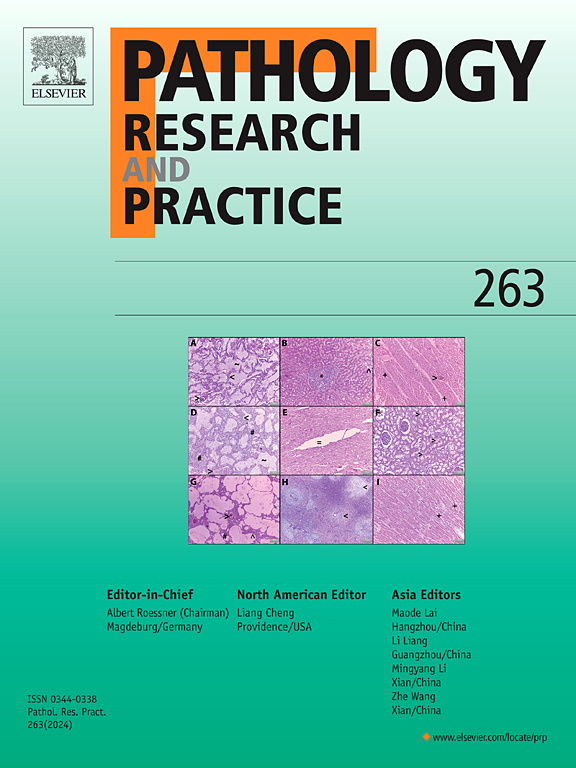Genetic characteristics of primary bone marrow large B-cell lymphoma
IF 3.2
4区 医学
Q2 PATHOLOGY
引用次数: 0
Abstract
Primary bone marrow large B-cell lymphoma (PBM-LBCL) is a rare entity with poorly defined genetic features. We performed whole-exome sequencing on bone marrow specimens from 19 PBM-LBCL cases and compared them with 11 cases of conventional diffuse large B-cell lymphoma (DLBCL) with secondary bone marrow involvement. Clinicopathological characteristics, including hemophagocytic lymphohistiocytosis (HLH), hepatosplenomegaly, International Prognostic Index (IPI) score, treatment with chemotherapy plus rituximab, CD5 expression, histopathological patterns, germinal center B-cell-like subtype and follow-up duration, did not differ significantly between the two groups. Both IPI score and treatment regimen emerged as independent predictors of survival. Sequencing analysis revealed 7974 moderate- to high-impact variants. The MCD molecular subtype predominated in both cohorts, while the EZB subtype was observed exclusively in PBM-LBCL. A distinct 16-gene mutational signature differentiated PBM-LBCL from DLBCL. Among these, 10 genes (KMT2D, APOB, BBS9, CFAP46, EIF4G3, FAT1, MED12L, TG, TNR, ZFHX4) were uniquely mutated in PBM-LBCL, and three genes (CNTNAP3B, IL16, ZNF814) were exclusive to DLBCL. Mutations in COL5A3, PCNT, HMCN2, and OSBPL10 were associated with HLH. Notably, BTG1 mutation was significantly associated with poor prognosis in both univariate and elastic net–regularized multivariate analyses. In summary, PBM-LBCL harbors a distinct genetic profile, characterized by a unique 16-gene signature that distinguishes it from DLBCL with secondary bone marrow involvement. BTG1 mutation is associated with adverse outcomes, highlighting their potential as prognostic biomarkers or therapeutic targets. These findings advance our understanding of the molecular landscape and prognostic stratification of PBM-LBCL.
原发性骨髓大b细胞淋巴瘤的遗传特征
原发性骨髓大b细胞淋巴瘤(PBM-LBCL)是一种遗传特征不明确的罕见疾病。我们对19例PBM-LBCL患者的骨髓标本进行了全外显子组测序,并将其与11例继发性骨髓受损伤的常规弥漫性大b细胞淋巴瘤(DLBCL)进行了比较。临床病理特征,包括噬血细胞淋巴组织细胞增多症(HLH)、肝脾肿大、国际预后指数(IPI)评分、化疗加利妥昔单抗治疗、CD5表达、组织病理模式、生发中心b细胞样亚型和随访时间,两组间无显著差异。IPI评分和治疗方案均成为独立的生存预测指标。测序分析显示有7974个中等到高影响变异。MCD分子亚型在两个队列中都占主导地位,而EZB亚型仅在PBM-LBCL中观察到。PBM-LBCL与DLBCL有明显的16个基因突变特征。其中,10个基因(KMT2D、APOB、BBS9、CFAP46、EIF4G3、FAT1、MED12L、TG、TNR、ZFHX4)在PBM-LBCL中特异突变,3个基因(CNTNAP3B、IL16、ZNF814)在DLBCL中特异突变。COL5A3、PCNT、HMCN2和OSBPL10突变与HLH相关。值得注意的是,在单变量和弹性净正则化多变量分析中,BTG1突变与不良预后显著相关。总之,PBM-LBCL具有独特的遗传谱,其特征是独特的16个基因特征,将其与继发性骨髓累及的DLBCL区分开来。BTG1突变与不良结果相关,突出了其作为预后生物标志物或治疗靶点的潜力。这些发现促进了我们对PBM-LBCL的分子景观和预后分层的理解。
本文章由计算机程序翻译,如有差异,请以英文原文为准。
求助全文
约1分钟内获得全文
求助全文
来源期刊
CiteScore
5.00
自引率
3.60%
发文量
405
审稿时长
24 days
期刊介绍:
Pathology, Research and Practice provides accessible coverage of the most recent developments across the entire field of pathology: Reviews focus on recent progress in pathology, while Comments look at interesting current problems and at hypotheses for future developments in pathology. Original Papers present novel findings on all aspects of general, anatomic and molecular pathology. Rapid Communications inform readers on preliminary findings that may be relevant for further studies and need to be communicated quickly. Teaching Cases look at new aspects or special diagnostic problems of diseases and at case reports relevant for the pathologist''s practice.

 求助内容:
求助内容: 应助结果提醒方式:
应助结果提醒方式:


